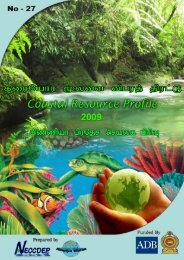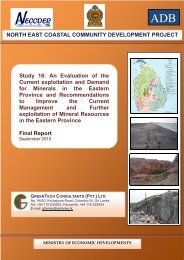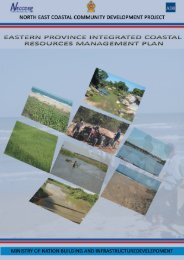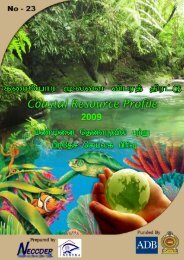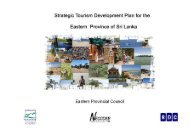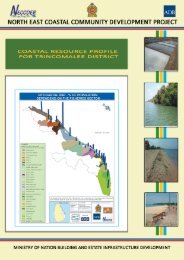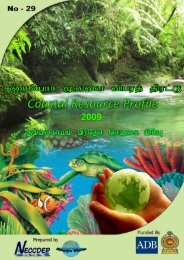Untitled - Neccdep.com
Untitled - Neccdep.com
Untitled - Neccdep.com
You also want an ePaper? Increase the reach of your titles
YUMPU automatically turns print PDFs into web optimized ePapers that Google loves.
TRINCOMALEE BAY SPECIAL MANAGEMENT AREA Page | 10<br />
II.<br />
SAM PLANNING PROCESS<br />
A. Scope of the planning process<br />
41. The process was initiated using the earlier terminology of Special Management Area<br />
(SMA) Planning resulting in the production of in interim SMA Plan. The terminology has<br />
subsequently been modified, in consultation with CCD, to reflect the terminology used in the<br />
2004 CZMP of Special Area Management (SAM).<br />
42. The scope of the process is to develop the SAM Plan in line with the CZMP 2004<br />
guidelines given in the CCD gazette notification of 2006. The SAM planning process will<br />
identifies issues which hamper the conservation of natural resources, sustainable utilization<br />
of natural resources and integrated development such as tourism.<br />
43. Through a participatory process of <strong>com</strong>munities and other stakeholders, the SAM<br />
Plan proposes remedial action to over<strong>com</strong>e the said issues. It should also provide a medium<br />
term (4 year) work plan to ensure the conservation of bay system, enhance the socioeconomic<br />
development of coastal <strong>com</strong>munities through sustainable utilization and also<br />
manage development using principles of vertical and horizontal integration. The SAM Plan<br />
also proposes an implementation mechanism and organizational structure to monitor the<br />
implementation process. An approximate cost estimate is also proposed including<br />
re<strong>com</strong>mendations for facilitating the generation of funds to support implementation.<br />
B. Standard SAM Planning process of CZMP of CCD<br />
44. Based on the planning process in pilot areas, Rekawa and Hikkaduwa, CCD has<br />
developed SAM planning guidelines to develop SAM Plans for other sites. These guidelines<br />
have been gazetted in Government Special Gazette Notification 2006. These guidelines are<br />
briefly described below.<br />
1. Selection of a site<br />
45. SAM sites identified by CZMP, 2004 can be selected for management by an<br />
implementing agency that can initiate SAM planning. A site specific plan should be prepared<br />
by the implementing agency for the selected site with active <strong>com</strong>munity participation enabled<br />
by professional facilitator/manager.<br />
2. Preparation of plan<br />
46. To ensure the preparation of standard SAM Plan for all SAM sites, the CCD has<br />
proposed the following process:<br />
a. Identification of issues through <strong>com</strong>munity consultation<br />
47. The Facilitator / Manager of the SAM site is responsible for identification and<br />
prioritizing of site specific issues through stakeholder consultation using an appropriate tool<br />
such as Participatory Rural Appraisal (PRA), Logical framework approach or Strengths,<br />
Weaknesses, Opportunities and Threats (SWOT) analysis. It should be noted that the<br />
identification of the magnitude of issues is not possible at this stage).<br />
b. Establishment of a Community Coordinating Committee<br />
48. A <strong>com</strong>munity Coordinating Committee (CCC) has to be established at the site to<br />
function as the SAM planning and implementation body. The CCC should <strong>com</strong>prise:



